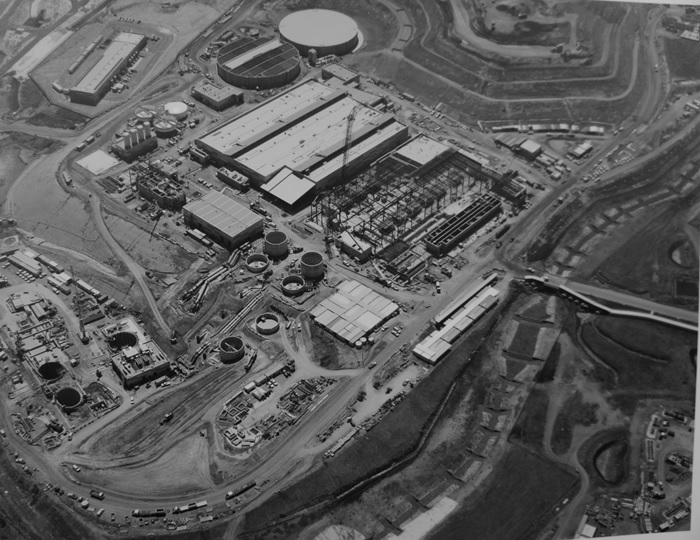Sustainable Piping Solution (for Adelaide Desalination Plant)

When the South Australian Premier, Mike Rann, first announced that the State Government would be building a AU$1.83 billion desalination plant in Adelaide, in 2007, Advanced Piping Systems (APS) jumped at the opportunity to showcase their capability in the area of environmentally sustainable, custom piping.
After winning the tender to supply all potable water lines, fire mains and associated fittings, including prefabricated spooling and giant diameter tank fittings, it was “straight to work” for the APS team.
Nathan Craig, Director at APS, said that the rapid project was ideal for APS, as the majority of their supplies are stored and fabricated on-site, making it easier for APS to meet their client’s needs on time and on budget.
“It was a fast start-up project, that needed dedicated support from the jump, and a supplier that knew what they were doing – not just a branch office struggling to round-up stock nationally,” Nathan said.
“We were able to quickly prove that we had what was needed for the massive project in-stock already, and our team could modify fittings the same day to suit any unplanned requirement, be it dimensional or totally hybrid invented, for a specific purpose.
“There was no need to wait for interstate supplies or overseas air freight to meet required demands and tight deadlines.”
An approach that clearly had an impact on the project, which started in October 2011 and finished on schedule and within budget on 26 March 2013 – an outcome Nathan believes was due to close consultation at the quoting stage.
“In pitching for the work, consultation with the client, Adelaide Aqua, and all three of their consortium contractors (McConnell Dowell Constructors, Abigroup Contractors, and ACCIONA Agua) was essential to ensuring the job came in on time and on budget,” he said.
“Our team always works to help minimise cost and presents possible cost and labour saving options to the original design.
“This consultation process is very valuable, as it provides increases in performance, reliability, and a less complicated installation process which ultimately saves time – and we all know time is the greatest cost to any construction project.
“At APS we present the solution in a simple, supported and clear way, so engineers and principles can approve cost savings and plans with complete confidence.”
Organised deliveries, training and flexibility
When it came time to build, Nathan said there were three key factors that kept the project on schedule from APS’s perspective: organised deliveries, training and flexibility.
“All deliveries were pre-arranged to fit into the intense crane lift schedules on site,” he said. “The bulk pipe was also pre-run and stored securely off site at the APS laydown facility, which reduced congestion on site.”
“Our guys also provided comprehensive training to the installation teams on the use of pipe preparation and welding equipment.
“Because of our capacity, and being local, we were also able to be incredibly flexible and reactive to the needs of the projects, providing fitting modifications, custom fabrications (such as 1600mm tank fittings), and respond quickly to delivery dates being brought forward or delayed to match new installation schedules.”
Ultimately, being such a large job APS understood that time was money, and their capacity and fabricating capability really allowed them to meet the demands of the project with relative ease.
“Reliability, whether it’s access to advice or depth of stock, and options is very, very important to a contractor achieving a project within budget and tight timeline,” Nathan said.
“The job went so well, we even ended up supplying a piping package to the Melbourne Desalination Plant project.”
A sustainable piping solution
Aside from being able to display their capacity and capability in delivering pipe and fabricated fittings within scheduled timelines, the Adelaide Desalination Plant project also gave APS the opportunity to showcase the benefits of HDPE pipe in meeting the sustainability requirements of the job.
“The whole project was about shoring up South Australia’s water supply, as the driest state in the driest continent,” Nathan said.
“By taking pressure off of the waterways, the aim was to secure availability to fresh water, while allowing for more water to flow down to the Murray River lake systems, keeping the Murray Mouth open during prolonged drought periods, and saving the fish and birdlife living in this unique ecosystem.”
As a result, building the plant in a way that met key sustainability guidelines and ratings, was essential for the Government and for Advanced Piping Systems.
“To ensure our piping system met the sustainability requirements of the job we supplied pipe that was made using a green material, PE100,” Nathan said.
“PE100 piping is 100% recyclable and the manufacturing of it is non-toxic and phthalate-free, in fact a lower grade version of it is used to make Glad Wrap which people use to cover and wrap food.
“At the time, projects requiring a minimum green star rating were removing PVC piping from their construction schedules and substituting it with PE100 piping to achieve an overall 5 star green rating – so by starting the Desalination Plant project with PE100 we were well ahead of the sustainability game.”
Pipe fittings used
The specific pipe and fittings used on the Adelaide Desalination Plant project include: Red Stripe and Blue Stripe PE100 Piping ranging from 63mm to 500mm, with PN16 Advanced Piping EF Fittings.

